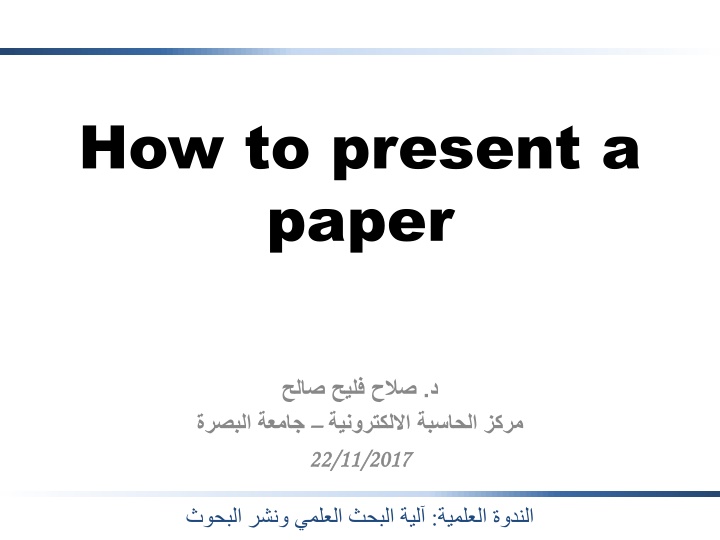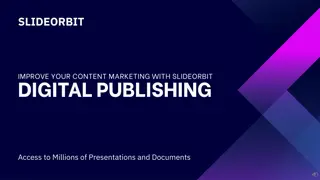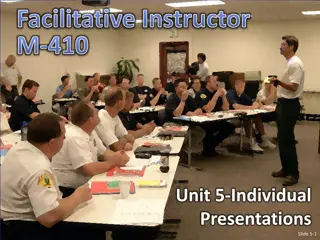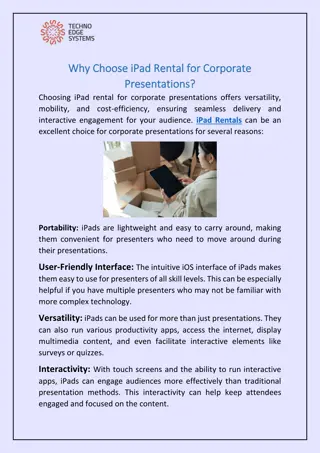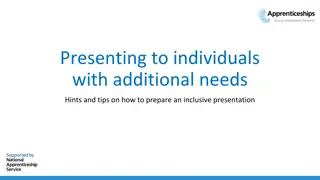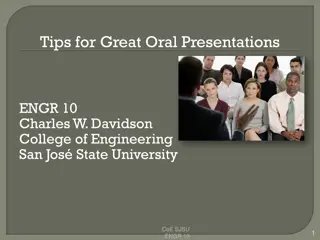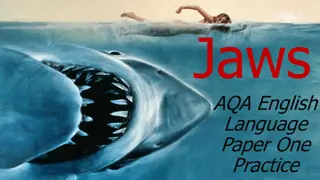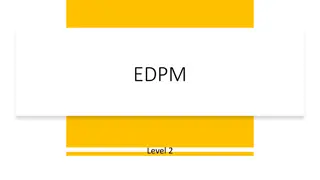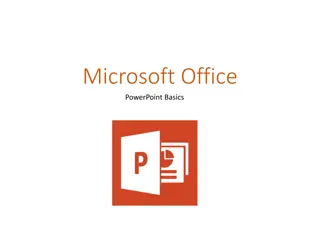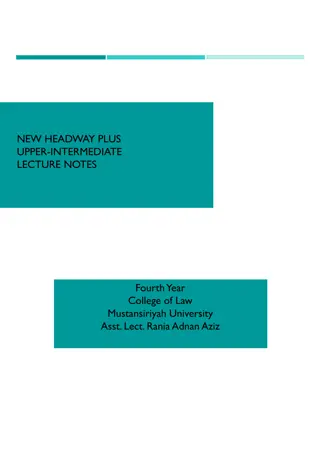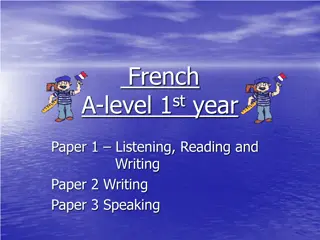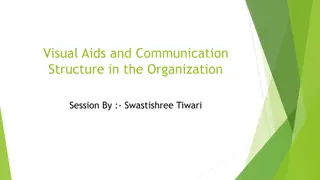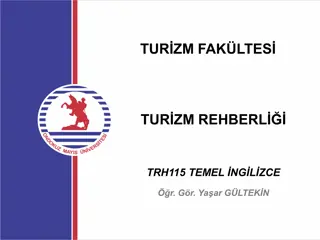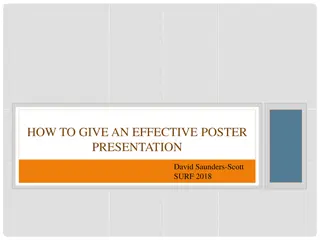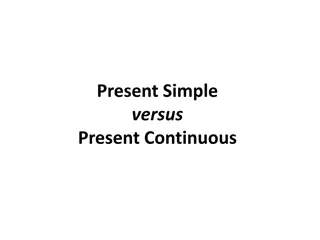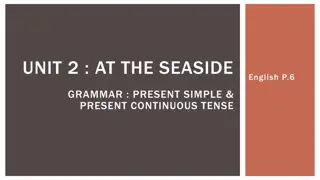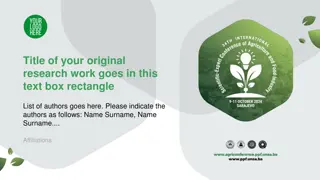How to Present a Paper: Effective Tips for Engaging Presentations
Presenting a paper effectively involves communicating key ideas, structuring your talk, and engaging the audience with visual aids. Learn how to define the problem, emphasize contributions, discuss major results, and use visual elements to enhance your presentation skills.
Download Presentation

Please find below an Image/Link to download the presentation.
The content on the website is provided AS IS for your information and personal use only. It may not be sold, licensed, or shared on other websites without obtaining consent from the author.If you encounter any issues during the download, it is possible that the publisher has removed the file from their server.
You are allowed to download the files provided on this website for personal or commercial use, subject to the condition that they are used lawfully. All files are the property of their respective owners.
The content on the website is provided AS IS for your information and personal use only. It may not be sold, licensed, or shared on other websites without obtaining consent from the author.
E N D
Presentation Transcript
How to present a paper 22 22/ /11 11/ /2017 . 2017 :
Contents 1. What to Say and How to Say It 2. Getting Through to the Audience 3. Visual and Aural Aids 4. Question Time How to Present your Paper
What to Say and How to Say It Communicate the Key Ideas Make sure that your talk emphasizes the key ideas Don t get Bogged Down in Details Details are out of place in an oral presentation Structure Your Talk Your presentation should be broken into several distinct parts Know Your Audience Make sure that your talk is prepared at the right level How to Present your Paper
What to Say and How to Say It The Introduction Define the Problem If the audience doesn t understand the problem, then they won t understand the rest Motivate the Audience Explain why the problem is so important Introduce Terminology All terms must be introduced early How to Present your Paper
What to Say and How to Say It The Introduction Discuss Earlier Work Explain why your work is different from others work Emphasize the Contributions of your Paper Explicitly and succinctly state the contributions made by your paper How to Present your Paper
What to Say and How to Say It The Body Abstract the Major Results Describe the key results of the presentation Explain the Significance of the Results Focus on anything unexpected or crucial to supporting your conclusions Sketch a Proof of the Crucial Results State the hypotheses and experimental design as simply as possible How to Present your Paper
What to Say and How to Say It The Body Use Pictures and Figures Digital photos are an easy way to share with the audience the physical arrangement of your experimental setup Don t Inflict Pain on the Audience Never waste an audience s time taking them through a step-by-step history of your projects Don t try to convince an uninterested audience that you were a superhuman How to Present your Paper
What to Say and How to Say It The Body Avoid Complex Tables Digital photos are an easy way to share with the audience the physical arrangement of your experimental setup Have a Purpose and Conclusion for Each Slide Always ask yourself Why do I need this slide? How to Present your Paper
What to Say and How to Say It The Conclusion Restate the lessons learned in a short manner Be Open About Problems Indicate that your Talk is Over How to Present your Paper
Getting Through to the Audience Practice Your Talk The practice must be verbal, not just mental Use Repetition Tell them what you re going to tell them (the Introduction) Tell them (the Body) And then tell them what you told them (the Conclusion) How to Present your Paper
Getting Through to the Audience Don t Read Your Slides Word-by-Word Convey Enthusiasm, Excitement, Confidence Let the audience know that you have something very interesting to share with them Don t Over-run when you are told that the talk is to last for 30 minutes, plan to talk for at most 25 minutes, and leave 5 minutes for question time How to Present your Paper
Getting Through to the Audience Maintain Eye Contact Spread your attention throughout the audience instead of concentrating on any one person or group Control Your Voice Speak clearly and with sufficient volume Don t speak in a monotone How to Present your Paper
Getting Through to the Audience Control Your Motion Use natural gestures Try not to remain rooted in one spot Minimize Language Difficulties Don t Start Your Talk with an Apology I really didn t have enough time to do my presentation . . .? The result is a lower expectation How to Present your Paper
Visual and Aural Aids Make it BIG Keep it Simple Make it Clear Be Consistent How to Present your Paper
Visual and Aural Aids Make it BIG (Text) This is Arial 24 This is Arial 32 This is Arial 36 This is Arial 44 This is Arial 12 Too small This is Arial 18 How to Present your Paper
Visual and Aural Aids Make it BIG (How to Estimate) Look at it from 2 meters How to Present your Paper
Visual and Aural Aids Keep it Simple (Text) Too many colors Too many fonts and styles The 6x7 Rule No more than 6 lines per slide No more than 7 words per line How to Present your Paper
Visual and Aural Aids Keep it Simple (Text) Information Technology: The term information technology was coined by the Harvard Business Review, in order to make a distinction between purpose-built machines designed to perform a limited scope of functions and general-purpose computing machines that could be programmed for various tasks. As the IT industry evolved from the mid- 20thcentury, it encompassed transistors and integrated circuits -- computing capability advanced while device cost and energy consumption fell lower, a cycle that continues today when new technologies emerge. Too Detailed How to Present your Paper
Visual and Aural Aids Keep it Simple (Text) Information Technology: Typically, IT is used in the context of enterprise operations as opposed to personal or entertainment technologies. The commercial use of IT encompasses both computer technology and telephony. Much Simpler How to Present your Paper
Visual and Aural Aids Keep it Simple (Text) Too Detailed How to Present your Paper
Visual and Aural Aids Keep it Simple (Text) Much Simpler How to Present your Paper
Visual and Aural Aids Keep it Simple (Pictures) Art work may distract your audience It doesn t substitute for content How to Present your Paper
Visual and Aural Aids Keep it Simple (Sound) Sound effects may distract your audience Use sounds only when necessary How to Present your Paper
Visual and Aural Aids Keep it Simple (Transition and Animation) Some transitions are annoying, not enhancing Less animation is better Appear and disappear are acceptable How to Present your Paper
Visual and Aural Aids Make it Clear (Capitalisation) ALL CAPITAL LETTERS ARE DIFFICULT TO READ Upper and Lower Case are Easier How to Present your Paper
Visual and Aural Aids Make it Clear (Fonts) Z Not Clear Z Clear Sanserif Serif How to Present your Paper
Visual and Aural Aids Make it Clear (Fonts) Serif fonts are difficult to read on screen Sanserif fonts are clearer Italic are difficult to read Normal or bold are clearer Underlines may signify hyperlinks Instead, use colors to emphasise How to Present your Paper
Visual and Aural Aids Make it Clear (Numbers) Use numbers for lists with sequence Use bullets to show a list without sequence or priority How to Present your Paper
Visual and Aural Aids Make it Clear (Colors) Use contrasting colors Light on dark vs. dark on light Use complementary colors Complement Complement Complement How to Present your Paper
Visual and Aural Aids Make it Clear (Size) Size implies importance How to Present your Paper
Visual and Aural Aids Make it Clear (Size) Size implies importance How to Present your Paper
Visual and Aural Aids Be Consistent Differences draw attention Differences may imply importance Use surprise to attract not distract How to Present your Paper
Visual and Aural Aids Be Consistent Differences draw attention Differences may imply importance Use surprise to attract not distract This tick draws attention How to Present your Paper
Visual and Aural Aids Be Consistent Differences draw attention Differences may imply importance oUse surprise to attract not distract These differences distract How to Present your Paper
Visual and Aural Aids Be Consistent Differences draw attention Differences may imply importance Use surprise to attract not distract This implies importance How to Present your Paper
Visual and Aural Aids Be Consistent Differences draw attention Differences may imply importance Use surprise to attract not distract Confusing differences How to Present your Paper
Visual and Aural Aids Be Consistent Differences draw attention Differences may imply importance Use surprise to attract not distract This surprise attracts How to Present your Paper
Visual and Aural Aids Be Consistent Differences draw attention Differences may imply importance Use surprise to attract not distract These distract How to Present your Paper
Question Time Expect three types of questions 1. The first is the genuine request for knowledge 2. The second is the selfish question, in which the questioner merely wishes to draw attention to him 3. The third and most important category is the malicious question How to Present your Paper
Question Time The best defense against these types of questions is to be prepared, Polite avoid getting involved in a lengthy exchange Offer to discuss it after the talk Do not be afraid to answer I don t know to some questions How to Present your Paper
Thank you for listening How to Present your Paper
